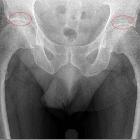Acetabulum
The acetabulum (plural: acetabula) is the large cup-shaped cavity on the anterolateral aspect of the pelvis that articulates with the femoral head to form the hip joint.
Gross anatomy
All three bones of the pelvis (the ilium, ischium, and pubis) together form the acetabulum. The three bones are initially separated by a Y-shaped triradiate cartilage that begins to fuse after puberty. The fusion is complete between 20 and 25 years of age .
The acetabular margin forms three quarters of a circle with a deficiency located anteroinferiorly called the acetabular notch. This depression is bridged with the transverse ligament of the hip, completing the circle and creating the acetabular foramen. The acetabular floor has a rough depression called the acetabular fossa that hosts the ligamentum teres. The acetabular fossa extends superiorly from the acetabular notch. The bone on the inner surface of the pelvis deep to the acetabular fossa is termed the quadrilateral plate and has clinical importance in classifying acetabular fractures.
The lip-shaped acetabular labrum is a fibrocartilaginous structure attached to the margin of the acetabulum, increasing the acetabular articular area. As a result, more than half of the femoral head fits within the acetabulum.
The column principle
The column principle divides the acetabulum into the anterior and posterior columns and becomes important when considering acetabular fractures and their management.
The anterior column is composed of the anterior ilium, anterior wall and dome of the acetabulum, and superior pubic ramus.
The posterior column is composed of the greater and lesser sciatic notches, posterior wall and dome of the acetabulum, and ischial tuberosity.
Anatomical variants
Related pathology
Siehe auch:
und weiter:

 Assoziationen und Differentialdiagnosen zu Acetabulum:
Assoziationen und Differentialdiagnosen zu Acetabulum:


